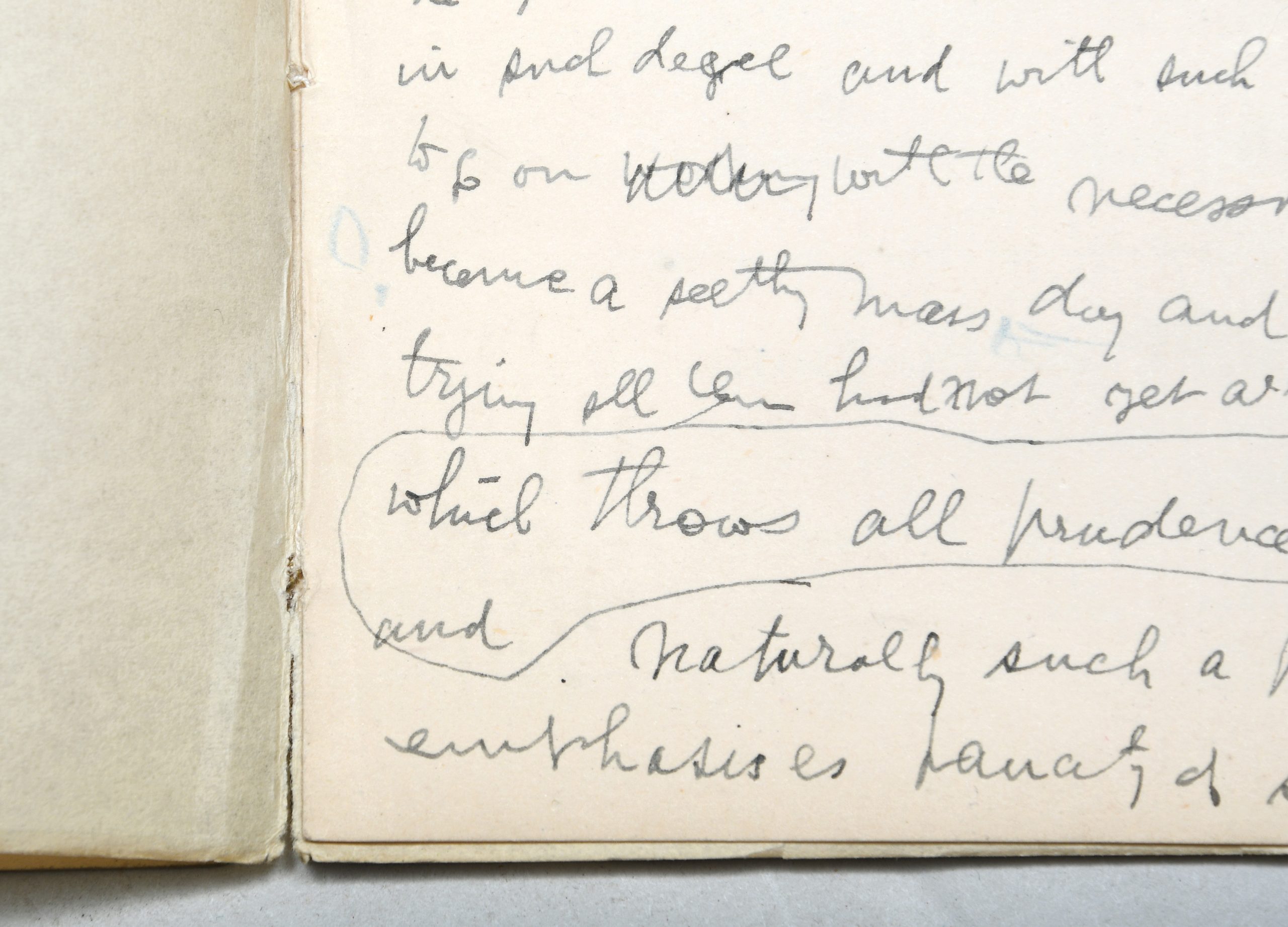Marginalia are any kind of marks of notes made in the margins and, together with inscriptions, and ephemeral works such as original letters and manuscripts, can add significantly to both the value and interest of an item. Notes, annotations, and inscriptions provide one of the most tangible windows into the place of books in the lives of notable figures, showing how they used, thought about, and read items in their library. Here we present several items which provide just such an insight into their owners’ relationship with the book as physical item.
Eliza Acton, Modern Cookery
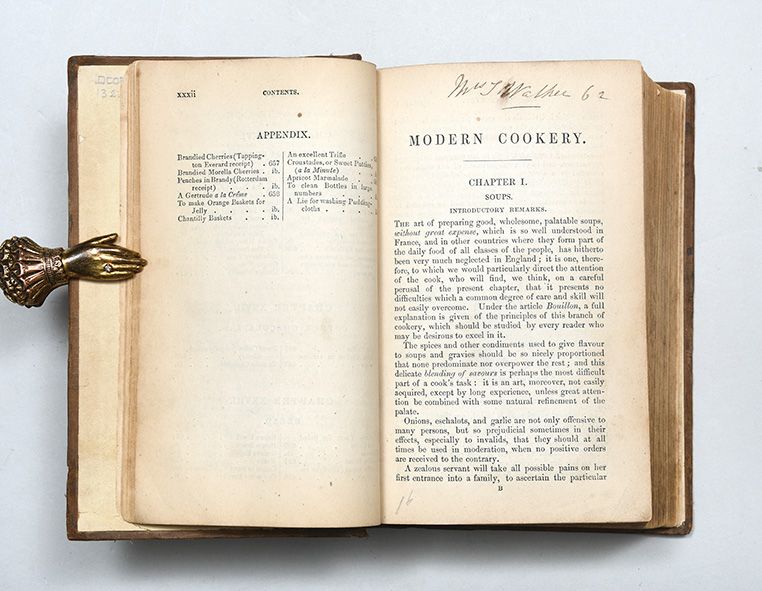 Sporting the occasional cookery stain, the sign of authentic domestic use, this 1845 cookbook was written by one of history’s first modern cookery writers, Eliza Acton. The text was progressive in its use of clear methodology and comprehensive detail: “what innovative was her original plan of listing, very exactly, the ingredients, the time taken, and possible pitfalls for the inexperienced cook. This was a completely new format, all other books on the subject being far less exact in their instructions” (ODNB). Other tantalising signs of use add to the book’s intrigue: select recipes checked in the margins, page corners previously folded to perhaps mark favourites, a hastily added scrap-paper bookmark, and the female ownership inscription of Mrs S. A. Walker, dated 1862, with her address given. Tangible evidence of daily life in the 19th century.
Sporting the occasional cookery stain, the sign of authentic domestic use, this 1845 cookbook was written by one of history’s first modern cookery writers, Eliza Acton. The text was progressive in its use of clear methodology and comprehensive detail: “what innovative was her original plan of listing, very exactly, the ingredients, the time taken, and possible pitfalls for the inexperienced cook. This was a completely new format, all other books on the subject being far less exact in their instructions” (ODNB). Other tantalising signs of use add to the book’s intrigue: select recipes checked in the margins, page corners previously folded to perhaps mark favourites, a hastily added scrap-paper bookmark, and the female ownership inscription of Mrs S. A. Walker, dated 1862, with her address given. Tangible evidence of daily life in the 19th century.
Bram Stoker
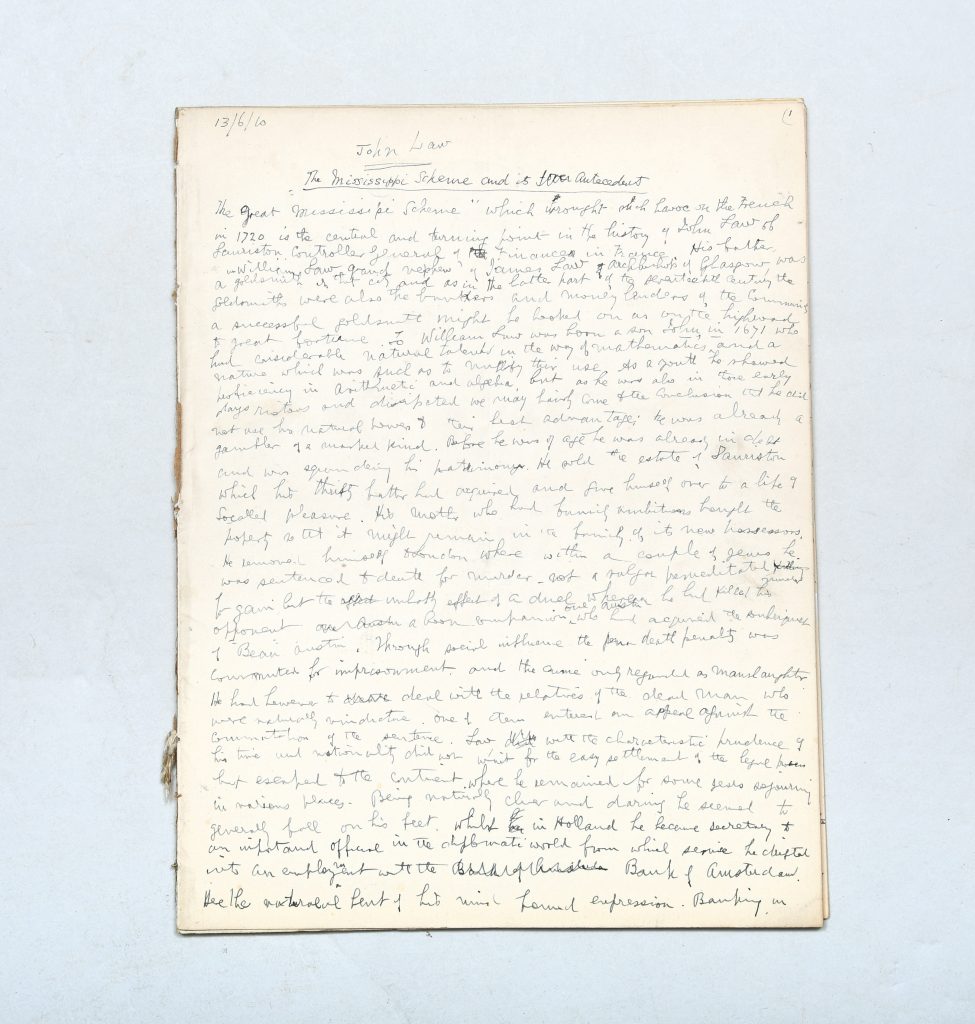 Completed in his own hand, this is a working manuscript of Bram Stoker’s essay on John Law – the Scottish economist who, as France’s Controller General of Finances infamously oversaw the collapse of the Banque Générale and the subsequent Mississippi Bubble, “a financial scheme in 18th-century France that triggered a speculative frenzy and ended in financial collapse” (Britannica). Stoker’s essay would provide the fourth chapter to his book Famous Imposters, an unusual study of duplicity and fraud throughout history. It was Stoker’s most popular work of nonfiction, chronicling the schemes of “impersonators, pretenders, swindlers, and humbugs of all kinds; those who have masqueraded in order to acquire wealth, position, or fame, and those who have done so merely for the love of the art” (preface). In his spidery handwriting, the manuscript is headed “John Law. The Mississippi Scheme and its fore Antecedent” and dated at the top “13/6/10”, with running dates in the left margins illustrative of when Stoker was at work (final date given “16/6”); the chapter also runs longer than would eventually be published, revealing Stoker’s editing style and discerning refinement of his work.
Completed in his own hand, this is a working manuscript of Bram Stoker’s essay on John Law – the Scottish economist who, as France’s Controller General of Finances infamously oversaw the collapse of the Banque Générale and the subsequent Mississippi Bubble, “a financial scheme in 18th-century France that triggered a speculative frenzy and ended in financial collapse” (Britannica). Stoker’s essay would provide the fourth chapter to his book Famous Imposters, an unusual study of duplicity and fraud throughout history. It was Stoker’s most popular work of nonfiction, chronicling the schemes of “impersonators, pretenders, swindlers, and humbugs of all kinds; those who have masqueraded in order to acquire wealth, position, or fame, and those who have done so merely for the love of the art” (preface). In his spidery handwriting, the manuscript is headed “John Law. The Mississippi Scheme and its fore Antecedent” and dated at the top “13/6/10”, with running dates in the left margins illustrative of when Stoker was at work (final date given “16/6”); the chapter also runs longer than would eventually be published, revealing Stoker’s editing style and discerning refinement of his work.
Nat Hentoff; Hugh Hefner
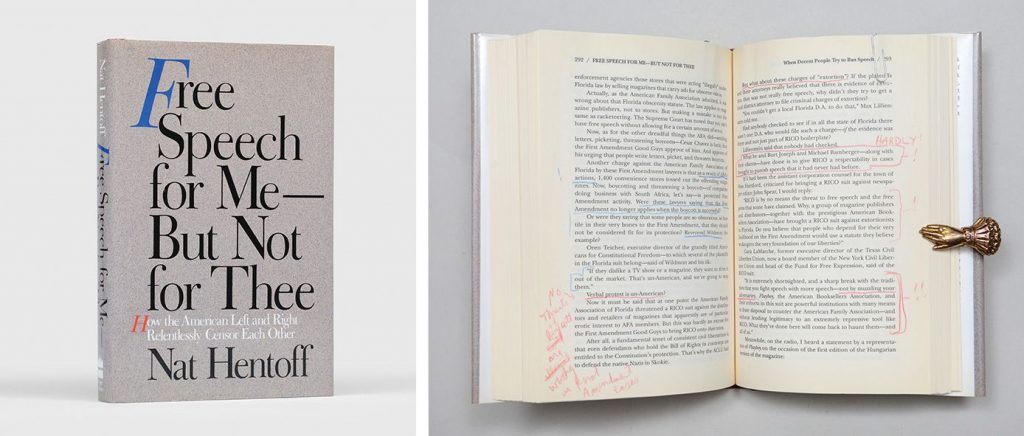 Hugh Hefner: founder of Playboy, pioneer in the ‘sex revolution’ of the 1960s, supporter of gay rights, perpetuator of female objectification: an icon to some, infamous to others, and also a staunch libertarian. In 1979, his daughter established The Hugh M. Hefner First Amendment Award “to honour individuals who have made significant contributions in the vital effort to protect and enhance First Amendment rights for Americans”. One of its first recipients was American historian, novelist, music critic and friend of Hefner, Nat Hentoff, who received the accolade for his 1980 book The First Freedom. In a personal copy of Hentoff’s 1992 book Free Speech For Me – But Not For Thee, the Playboy editor read and eagerly annotated the author’s writing on civil liberties with exclamation marks, underlines and paper-clips as page markers. One passage in particular, on the attempt by the American Family Association of Florida to boycott stores selling Playboy, which led 7-Eleven to cease stocking the titles, ignited Hefner: “No! Threats of boycott are illegal wrong in First Amendment Cases” (p. 292).
Hugh Hefner: founder of Playboy, pioneer in the ‘sex revolution’ of the 1960s, supporter of gay rights, perpetuator of female objectification: an icon to some, infamous to others, and also a staunch libertarian. In 1979, his daughter established The Hugh M. Hefner First Amendment Award “to honour individuals who have made significant contributions in the vital effort to protect and enhance First Amendment rights for Americans”. One of its first recipients was American historian, novelist, music critic and friend of Hefner, Nat Hentoff, who received the accolade for his 1980 book The First Freedom. In a personal copy of Hentoff’s 1992 book Free Speech For Me – But Not For Thee, the Playboy editor read and eagerly annotated the author’s writing on civil liberties with exclamation marks, underlines and paper-clips as page markers. One passage in particular, on the attempt by the American Family Association of Florida to boycott stores selling Playboy, which led 7-Eleven to cease stocking the titles, ignited Hefner: “No! Threats of boycott are illegal wrong in First Amendment Cases” (p. 292).
Beatrix Potter; Beatrix Heelis
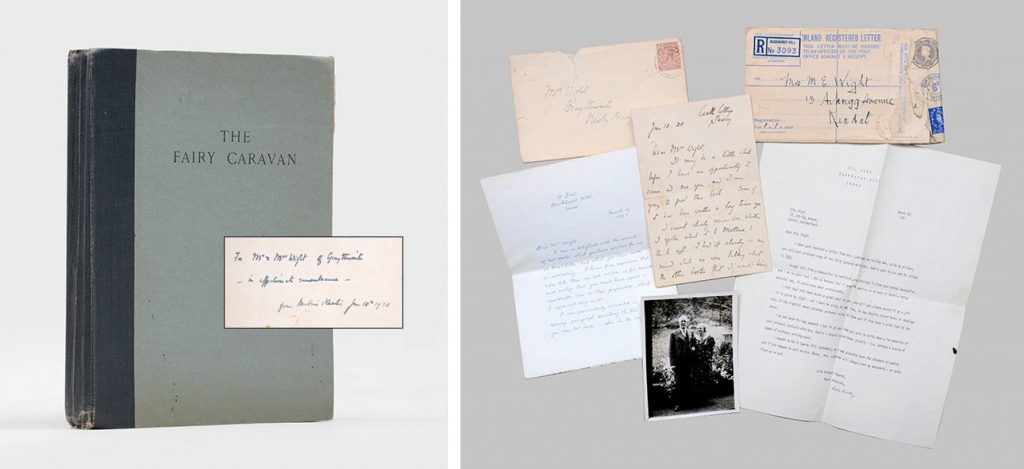 This presentation copy of Beatrix Potter’s 1929 children’s story The Fairy Caravan contains a consoling inscription to the author’s friends Mr & Mrs Wight, a dedication to their late daughter Mollie: “To Mr & Mrs Wight of Graythwaite – in affectionate remembrance – from Beatrix Heelis. June. 10th 1930”. Accompanying the book is a compassionate letter. Potter (whose married name was Heelis) expresses her earlier intention to have given a copy of The Fairy Caravan to Mollie and her wish, for the bereaved parents, that “time is softening the pain of parting and that you can take comfort in thinking of her safe from the storms and cold of this earthly pilgrimage.” The book’s provenance adds to its poignancy. Mrs Wight mistakenly sold this copy and, after passing through the hands of two booksellers, it was finally purchased by Leslie Linder. In a letter laid into the book, addressed from Linder to Mrs Wight, he returns The Fairy Caravan to its rightful owner, and asks not for compensation but for memories Wight might have of Potter. There is no record of her reply, but Linder’s response to her note also accompanies the book, thanking her “for the account of Mrs Heelis… I know from experience that notes like these are not written in five minutes.”
This presentation copy of Beatrix Potter’s 1929 children’s story The Fairy Caravan contains a consoling inscription to the author’s friends Mr & Mrs Wight, a dedication to their late daughter Mollie: “To Mr & Mrs Wight of Graythwaite – in affectionate remembrance – from Beatrix Heelis. June. 10th 1930”. Accompanying the book is a compassionate letter. Potter (whose married name was Heelis) expresses her earlier intention to have given a copy of The Fairy Caravan to Mollie and her wish, for the bereaved parents, that “time is softening the pain of parting and that you can take comfort in thinking of her safe from the storms and cold of this earthly pilgrimage.” The book’s provenance adds to its poignancy. Mrs Wight mistakenly sold this copy and, after passing through the hands of two booksellers, it was finally purchased by Leslie Linder. In a letter laid into the book, addressed from Linder to Mrs Wight, he returns The Fairy Caravan to its rightful owner, and asks not for compensation but for memories Wight might have of Potter. There is no record of her reply, but Linder’s response to her note also accompanies the book, thanking her “for the account of Mrs Heelis… I know from experience that notes like these are not written in five minutes.”
Vladimir Nabokov, Nikolai Gogol
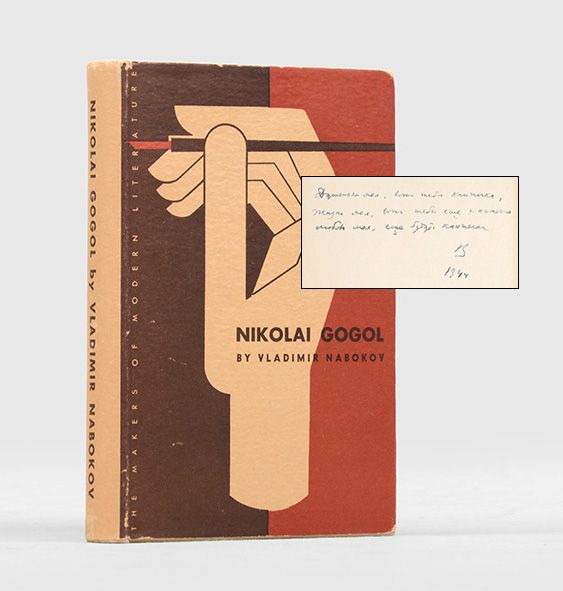 In his native language, Nabokov wrote a romantic message to his wife Véra in this copy of his biography of Russian novelist Nikolai Gogol: “My beloved, here’s a little book for you, my life, here’s another little book for you, my love, there will be more little books…” Editions of Nikolai Gogol inscribed or annotated by Nabokov are extremely uncommon, and one so intimate as this is exceptional. Contributing to the insight the item offers us into his personal thoughts, Nabokov has also made other annotations in nearly 60 instances, including criticism of his own use of English (this being the first book the author wrote in English). A literary innovator and surrealist working in the nineteenth century, Gogol’s work, characterised as “displays of the fantasies of the human spirit” by Penguin Books, was deeply underappreciated in his own time. Nabokov’s biography begins at the end of Gogol’s life and ends at its beginning – an inverted structure typical of both authors.
In his native language, Nabokov wrote a romantic message to his wife Véra in this copy of his biography of Russian novelist Nikolai Gogol: “My beloved, here’s a little book for you, my life, here’s another little book for you, my love, there will be more little books…” Editions of Nikolai Gogol inscribed or annotated by Nabokov are extremely uncommon, and one so intimate as this is exceptional. Contributing to the insight the item offers us into his personal thoughts, Nabokov has also made other annotations in nearly 60 instances, including criticism of his own use of English (this being the first book the author wrote in English). A literary innovator and surrealist working in the nineteenth century, Gogol’s work, characterised as “displays of the fantasies of the human spirit” by Penguin Books, was deeply underappreciated in his own time. Nabokov’s biography begins at the end of Gogol’s life and ends at its beginning – an inverted structure typical of both authors.
Lord Edward Plunkett Dunsany, Nowadays
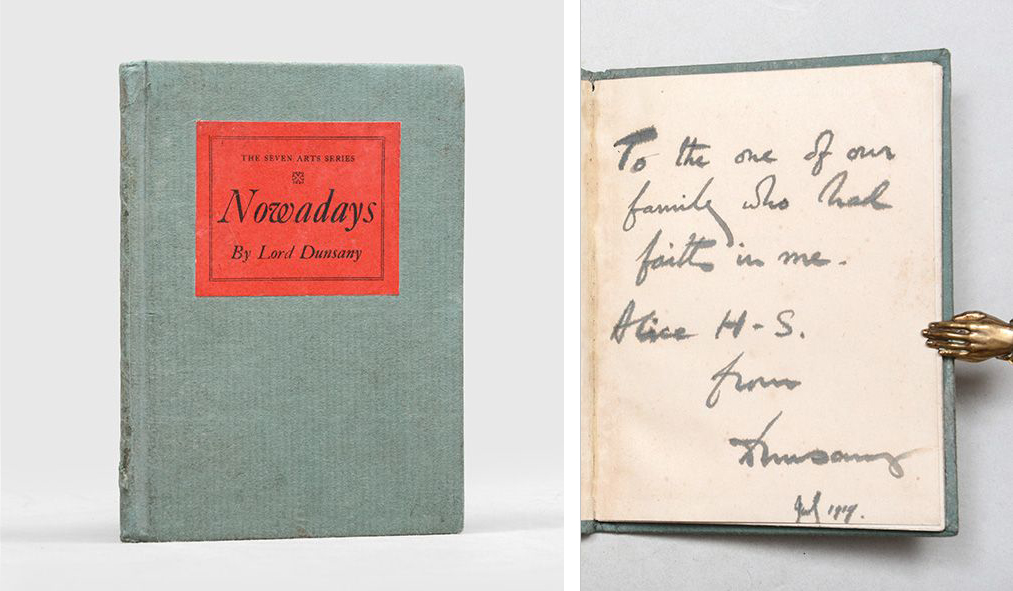 In a touching tribute to his cousin Alice Holroyd Smyth (née Ponsonby), Lord Dunsany inscribed this first edition, first impression of his published essay Nowadays to her with gratitude: “To the one of our family who had faith in me. Alice H. S. from Dunsany, July 1919”. Nowadays, a work refuting the notion that “poetry is dead”, was first delivered by Lord Dunsany at the Poet’s Club in London in July, 2012 (Joshi, 1995). Holroyd Smyth, who “wrote the chess problems for The Field in addition to quite good poetry”, has herself marked with pencil two passages in the text emphasising the merits of poets. Like Dunsany, Holroyd Smith was Anglo-Irish; her connections with the IRA are exemplified by extensive correspondence with members local to her, which may be why her estate was never targeted by the group.
In a touching tribute to his cousin Alice Holroyd Smyth (née Ponsonby), Lord Dunsany inscribed this first edition, first impression of his published essay Nowadays to her with gratitude: “To the one of our family who had faith in me. Alice H. S. from Dunsany, July 1919”. Nowadays, a work refuting the notion that “poetry is dead”, was first delivered by Lord Dunsany at the Poet’s Club in London in July, 2012 (Joshi, 1995). Holroyd Smyth, who “wrote the chess problems for The Field in addition to quite good poetry”, has herself marked with pencil two passages in the text emphasising the merits of poets. Like Dunsany, Holroyd Smith was Anglo-Irish; her connections with the IRA are exemplified by extensive correspondence with members local to her, which may be why her estate was never targeted by the group.

